
by Mike Quigley | May 22, 2018 | Blog

Let’s assume that you have been in your home for 30 years and that you have diligently kept up with maintenance. The kids have moved out and you are ready to move to warmer climates. You call your local Real Estate Agent, who recommends a little staging; taking down personal pictures, de-cluttering, painting, and so on. You feel confident that you are ready to put your house on the market.
The agent finds a buyer for your house. The buyer then hires a Home Inspector. The inspector shows up and proceeds to take hundreds of pictures of your home and then writes up a lengthy, not so flattering, report on your property. The buyer walks away from the deal.
What went wrong? To the untrained eye, the property appears to be in great condition. Nevertheless, if your home was built 30 or more years ago, the home inspector may have found:
1. Asbestos tiles on the floor;
2. Asbestos and lead paint on the popcorn-finished ceiling;
3. A Federal Pacific electrical panel that has been recalled;
4. Siding that is the subject of a class action lawsuit against the manufacturer;
5. Possible PCB and asbestos-contaminated storm window caulking;
6. Caulking covering the weep holes in the storm windows;
7. No safety glass in any of the doors;
8. Lead paint everywhere;
9. No Wythe or flue separator in the fireplace;
10. No anti-tipping device on the gas stove;
11. The gas stove does not vent to the exterior;
12. No GFCI (Ground Fault Circuit Interrupter) receptacles anywhere;
13. No AFCI (Arc-Fault Circuit Breakers) in the panel;
14. An open sump pump in the basement;
15. Missing hand railings;
16. Insulation installed with an exposed vapor barrier;
17. A missing attic ventilation system;
18. Mold on the attic sheathing; and
19. Termite entry at the base of the basement stairs and continuing up to the first-floor joists.
Your first reaction to the failed sale of your home might be anger at the inspector. It is not the Inspector’s fault; he or she is simply doing the job he or she was hired to do and pointing out the facts about an aging property. If you stop and think about it, you would want the same level of professionalism and attention to these important details if you were the buyer. But, how would you know all these problems were in your own home?
Unless you are in the industry, building or inspecting homes, you wouldn’t be expected to know about these things. It can be very helpful, before you list your home for sale, to have a home inspector do a seller’s consultation for you. If he finds any problems that might slow down or stop the sale of your home, you can fix it before you list it or at the very least, know what will potentially turn up on a buyer’s inspection.

by Mike Quigley | Oct 5, 2017 | Blog
Watch this slideshow/video presentation on how a water leak turned into a much larger mold problem. All of the photographs were taken at the same property.
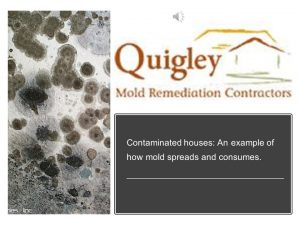

by Mike Quigley | Jul 23, 2017 | Blog
Indicators of mold in an attic do not necessarily mean mold growth or activity. Excessive water vapor must be present for that to happen. Mold spores that grow on wood start out in a circular manner then send out feeding tubes that resemble fingers on a hand.
Insulation traps water vapor. Particularly with dirt basements, water vapor will migrate through the house eventually settling in the attic. Each layer of added insulation will trap more water vapor which will create an environment for mold growth. A dirt basement would have to have a vapor barrier installed and an adequate attic ventilation system would have to be improved upon or installed to handle the effects of additional insulation.
In nearly 100% of the attics we remediate, additional insulation was the culprit. If you call an insulation company to add additional insulation, they will likely request that you have your attic remediated for mold (even if it’s not necessary) before they install the insulation, leaving any responsibility for new mold growth to the homeowner. Before you consider having insulation installed, take care of the vapor and ventilation issues first.
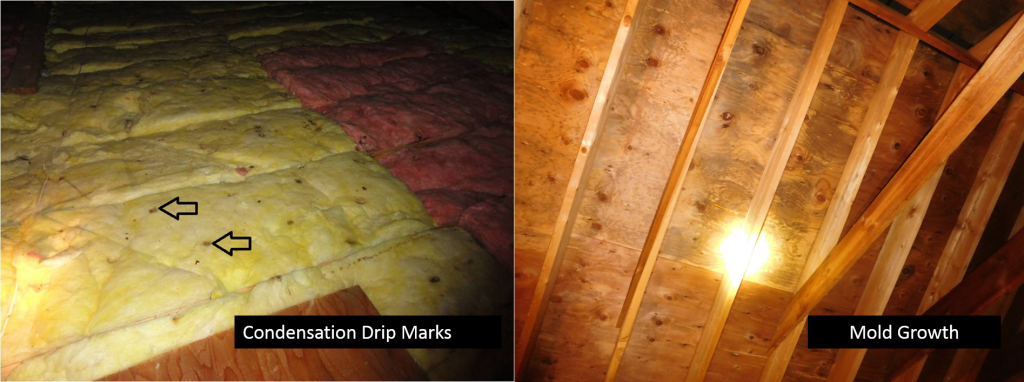

by Mike Quigley | May 12, 2017 | Blog

When preparing a house for sale, the usual steps are to make sure things are uncluttered, clean, smell nice and are generally spiffed up.
As a licensed home inspector and mold remediation contractor, there are four things that I consistently see holding up, slowing down or even be a deal-breaker on a sale. I encourage all sellers to make sure the following items are handled prior to listing and showing a property for sale.
- If you live in Massachusetts and have a septic system, a seller is required to have a Title 5 inspection. Have it done and be able to present the certificate to your potential buyer when it passes, or fix what needs to be fixed to make it pass.
- There is mold in a great percentage of attics because houses are now so well-insulated with improper ventilation, or maybe there was an ice dam situation. Mold remediation usually takes only a few hours with a transferable warranty to that new buyer.
- Have an electrician make sure your electric panel is up to code.
- Test the home for radon. Radon testing kits are easily available and simple to use.

by Mike Quigley | Apr 28, 2017 | Blog
Mold growth in a home is the result of increased trapped water vapor. Water vapor is of course caused by a number of sources including: bathroom fans venting into the attic, cooking, showering, improperly vented dryers etc.
But water entry can happen in an area that you may not think of.
What could your electrical service have to do with mold? If the electrical service into your home is installed incorrectly, (where the weather head is lower than the electrical service attachment point), water can enter the circuit breaker panel and evaporate into the basement. Moving past the obvious fire hazard of water and electricity, this is an overlooked source of water entry into the home. The pictures are numbered in order of how water can enter through the electrical service:
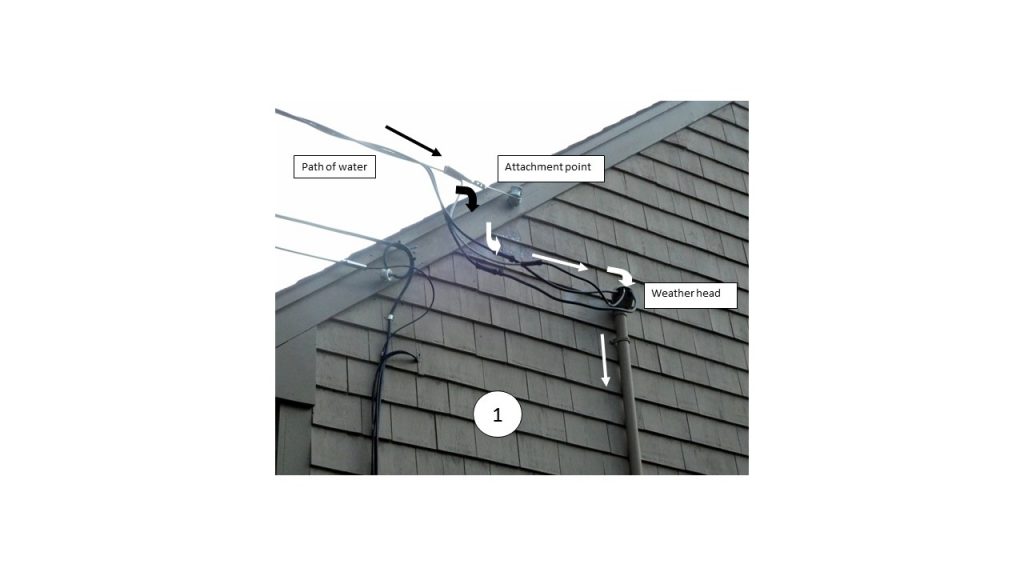
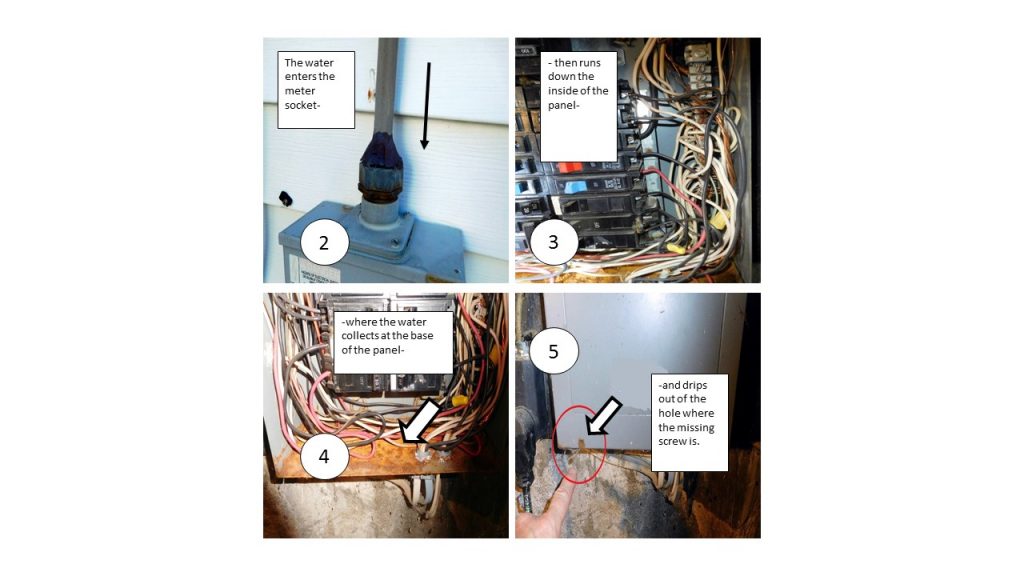
I’m sure that if you are a home inspector, you also noted the over full panel, the double tapping, the spliced wires, as well as the neutrals and grounds under the same lug. The main point is that water entry can come from a number of places, some of them you might not immediately think of.

by Mike Quigley | Apr 19, 2017 | Blog
Today’s tip is to check the bathroom fan. Make sure it does not vent the into the attic. The excess humidity can cause mold to grow on the attic sheathing. The blackened insulation in the picture is a combination of moisture and dust. Mold does not grow on fiberglass insulation, but it can grow
on the dust trapped
in the insulation. Remember that mold only eats damp
digestible materials. Mold will grow on the paper backing of the insulation.
Notice the moisture soaked blackened insulation:
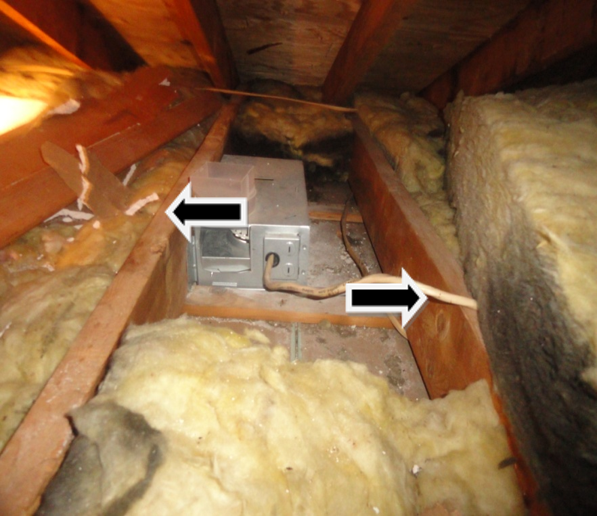





 When preparing a house for sale, the usual steps are to make sure things are uncluttered, clean, smell nice and are generally spiffed up.
As a licensed home inspector and mold remediation contractor, there are four things that I consistently see holding up, slowing down or even be a deal-breaker on a sale. I encourage all sellers to make sure the following items are handled prior to listing and showing a property for sale.
When preparing a house for sale, the usual steps are to make sure things are uncluttered, clean, smell nice and are generally spiffed up.
As a licensed home inspector and mold remediation contractor, there are four things that I consistently see holding up, slowing down or even be a deal-breaker on a sale. I encourage all sellers to make sure the following items are handled prior to listing and showing a property for sale.


